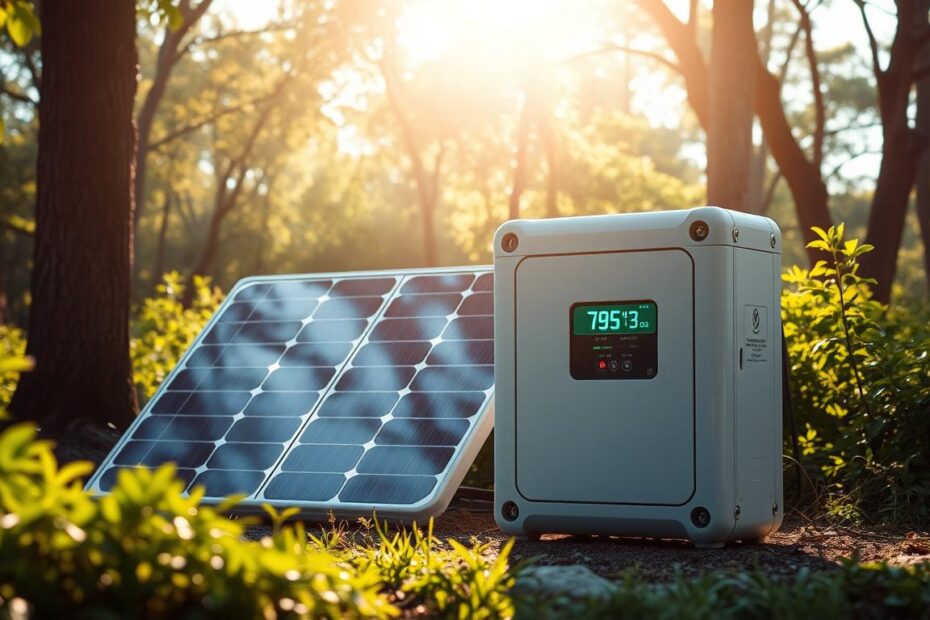The heart of any solar panel system is its battery. These silent guardians store the sun’s power. They ensure your home or business has reliable electricity, even when it’s cloudy. Choosing the right battery is key to a system that meets your needs and saves you money.
Imagine you’ve just installed your solar panels, ready to cut down on energy bills. But without a reliable battery, your system isn’t complete. The right battery choice can turn your solar setup into a self-sustaining powerhouse. It gives you energy security and independence.
Key Takeaways
- Solar battery systems can cost between $5,000 and $30,000, with the Inflation Reduction Act providing a 30% tax credit. Click here to see how you can reduce your electricity bills.
- Lithium-ion batteries offer superior depth of discharge, lifespan, and efficiency compared to lead-acid options.
- Battery capacity, measured in kWh, determines the amount of energy storage, while power rating indicates the energy release rate.
- Consider factors like cycle life, temperature range, and self-discharge rates when evaluating battery performance.
- Proper battery sizing, voltage matching, and charge controller selection are crucial for optimal solar system integration.
Understanding the Importance of Battery Selection
Batteries are key to making solar power systems work well. They help store extra electricity made by solar panels during the day. This stored power is used when the sun is not out, like at night, or on cloudy days.
Why Batteries Matter in Solar Systems
Without batteries, solar panels can only power homes or businesses when it’s sunny. I don’t think anyone would want that. However, batteries store electricity for later use, ensuring a steady power supply for you and your home. This makes your solar system more efficient and independent from the grid.
The Role of Batteries in Energy Storage
Batteries are vital for storing energy in solar systems. They hold extra power for use when the sun is not shining or during outages. This stored power is crucial during emergencies, keeping your home or business running smoothly.
Choosing the right battery is important for your solar system’s performance and life. The correct battery ensures your solar system works at its best, giving you true energy freedom.
Types of Batteries for Solar Panel Systems
The type of battery you choose for your solar panel system is crucial. It affects how well your system works and how efficient it is. Let’s look at the main battery options for solar use:
Lead-Acid Batteries
Lead-acid batteries have been used in solar systems for many years. They are reliable and affordable. You can find them in flooded and sealed types, like Absorbent Glass Mat (AGM) batteries. Even though they don’t last as long as newer batteries, they are still a favorite for their cost and reliability.
Lithium-Ion Batteries
Lithium-ion batteries are becoming more popular for solar systems. They have more energy, last longer, and work better than lead-acid batteries. The Tesla Powerwall is a well-known lithium-ion battery for homes.
Saltwater Batteries
Saltwater batteries are a newer, green option. They use saltwater as the electrolyte, making them recyclable. These batteries are safe, last a long time, and need little upkeep.
AGM (Absorbent Glass Mat) Batteries
AGM batteries are a special kind of lead-acid battery. They have a glass mat that holds the electrolyte, making them spill-proof. They are good for many uses, including storing solar energy.
New battery tech, like Lithium Iron Phosphate (LFP) cathodes, has improved lithium-ion batteries. They are cheaper, perform better, and are safer. As solar tech grows, more battery choices are available. This gives homeowners more ways to improve their solar setups.
| Battery Type | Lifespan (Cycles) | Efficiency | Cost per kWh |
|---|---|---|---|
| Lead-Acid | 500-1000 | 80-90% | $100-$200 |
| Lithium-Ion | 3000-5000 | 90-95% | $500-$1000 |
| Saltwater | 5000-10000 | 85-90% | $500-$700 |
| AGM | 500-1000 | 85-92% | $150-$300 |
“As the solar industry continues to evolve, the range of battery options for solar panel systems is expanding, providing homeowners with more choices to optimize their renewable energy setup.”
Key Factors to Consider When Choosing a Battery
When picking a solar battery, think about a few important things. The battery’s size, how long it lasts, and how much you can use from it are key. These factors affect how well your solar system works and lasts.
1. Capacity and Storage Size
The battery’s capacity is measured in kilowatt-hours (kWh), and this depends on the battery model. A 10 kW battery can really use about 9 kW, since it works at 90% capacity.
2. Battery Lifespan
Solar batteries usually have 10 or 15-year warranties. But, how long they actually last can vary depending on the technology, how you use it, and if you keep it up. For example, lead-acid batteries last 500-1000 cycles, while lithium-ion can go up to 5000 cycles.
3. Depth of Discharge (DoD)
The DoD is also important. A higher DoD means you can use more of the battery before needing to recharge. So try to aim for a DoD of about 80% to make your battery last longer.
| Battery Type | Cycle Life | Lifespan | Cost per kWh |
|---|---|---|---|
| Lead-Acid | 500-1000 cycles | 1.5-3 years with daily cycling | $100 – $200 per kWh |
| Lithium-Ion | 3000-5000 cycles | 8-13 years | $500 – $1,000 per kWh |
| Saltwater | 3000-5000 cycles | 10-15 years | $500 – $700 per kWh |
| AGM | 500-1000 cycles | 5-7 years | $150 – $300 per kWh |
Think about these factors to choose the right battery for your solar system. This ensures your system works well and stores energy for a long time so that you can also keep your energy bill low if you are still using the grid.
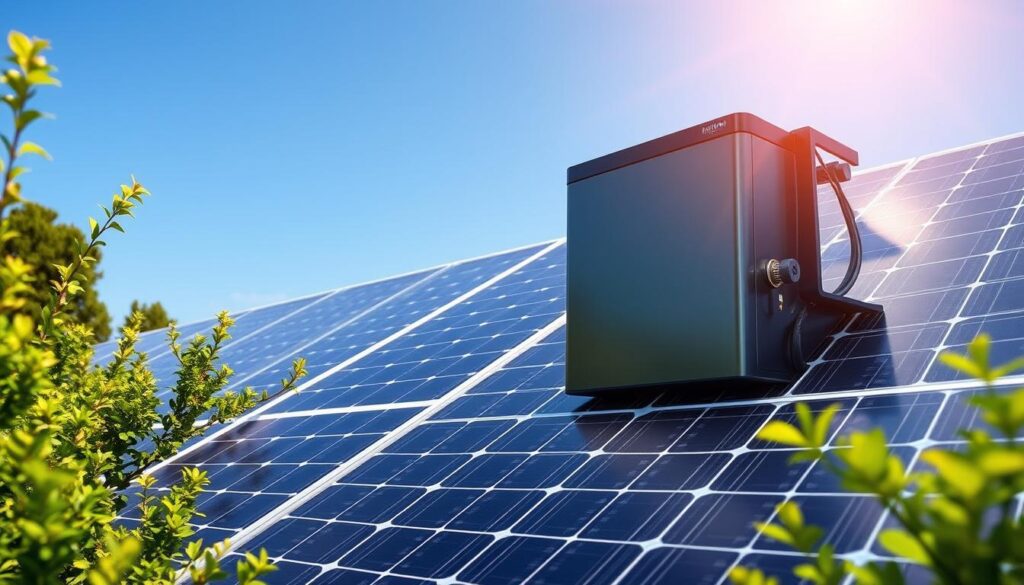
Evaluating Efficiency and Performance
Efficiency and performance are key when choosing solar battery systems. The round-trip efficiency shows how much usable energy you get from stored energy. Higher efficiency means more value for your money. Solar batteries with 90% to 95% round-trip efficiency can use more energy from your solar panels.
Cycle life is also vital, and it shows how many times a battery can charge and discharge before losing a lot of capacity. Lead-acid batteries last 500-1000 cycles, while lithium-ion batteries can handle 3000-5000 cycles. This makes lithium-ion batteries a better choice for long-term use, and because you won’t have to replace them regularly, they can save you money.
Temperature Range and Conditions
Temperature greatly affects solar battery performance. What you need to know is that extreme temperatures can reduce efficiency and lifespan. As such, it’s important to pick a battery that works well in your local climate to ensure the best solar battery performance and energy efficiency.
Self-Discharge Rates
Self-discharge rate is another important factor. It’s how much charge a battery loses when not in use. Batteries with lower self-discharge rates keep their charge longer. This means you don’t have to recharge them as often, improving your solar power system’s efficiency.
| Battery Type | Round-Trip Efficiency | Cycle Life | Self-Discharge Rate |
|---|---|---|---|
| Lead-Acid | 80-90% | 500-1000 cycles | 2-5% per month |
| Lithium-Ion | 90-95% | 3000-5000 cycles | 1-3% per month |
| Saltwater | 85-90% | 2000-3000 cycles | 1-2% per month |
| AGM | 85-92% | 1000-2000 cycles | 2-4% per month |
By looking at efficiency and performance metrics, you can choose the right solar battery for your needs. This ensures you get the most out of your solar power system.
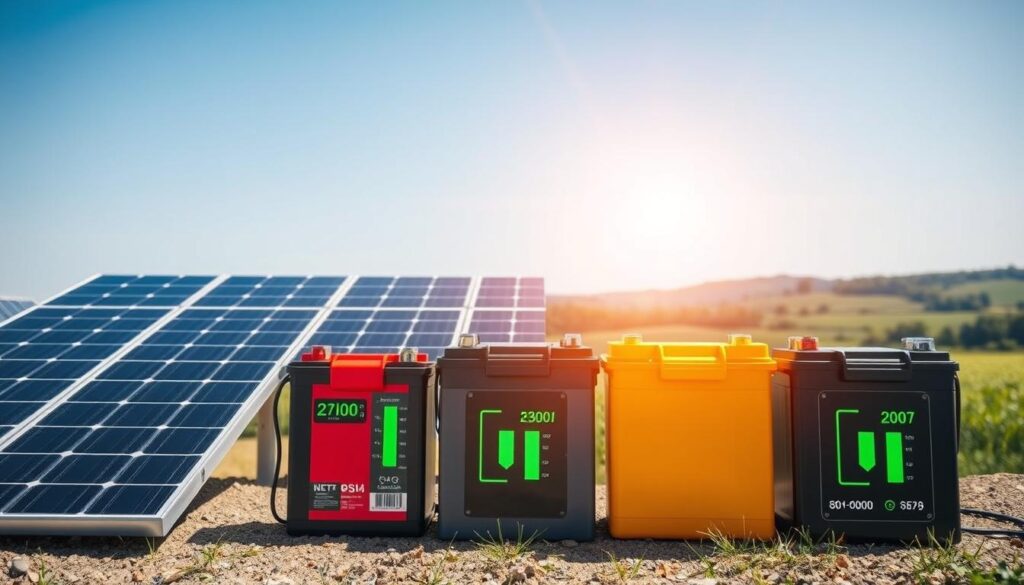
Budget Considerations for Solar Batteries
Getting a solar battery system can cost a lot upfront. But, the long-term savings and benefits are worth it for many homeowners. The cost varies from $5,000 to $30,000, based on the size and quality of the batteries. Luckily, there are financing options and incentives to help with the cost.
Click here to learn about a simple solution that can help reduce your power bills.
Initial Costs vs. Long-Term Savings
The initial cost of solar batteries might seem steep, however, the long-term savings are significant! Solar batteries cut down on grid reliance and store extra energy for when you need it most. This can lower your energy bills. Plus, for those in the USA, the federal Investment Tax Credit (ITC) can cover 30% of the system’s cost, making your investment more appealing.
Financing Options Available
There are many ways to finance solar batteries. You can get solar loans, leases, or power purchase agreements (PPAs). Loans let you pay for the system over time. Leases and PPAs mean a third-party company owns and maintains the system, with you paying a monthly fee for the electricity it produces.
Understanding Warranty and Support
It’s important to know the warranty and support from the manufacturer when choosing a solar battery. Warranties usually promise a certain number of cycles or years of life, often with a capacity guarantee. Researching these details ensures your investment is well-protected.
| Battery Type | Cost per kWh | Cycle Life | Lifespan |
|---|---|---|---|
| Lead-Acid | $100 – $200 | 500 – 1,000 | 1.5 – 3 years |
| Lithium-Ion | $500 – $1,000 | 3,000 – 5,000 | 8 – 13 years |
Understanding budget, financing, and warranty details helps you choose the right solar battery system for your home. This ensures you meet your energy needs effectively.
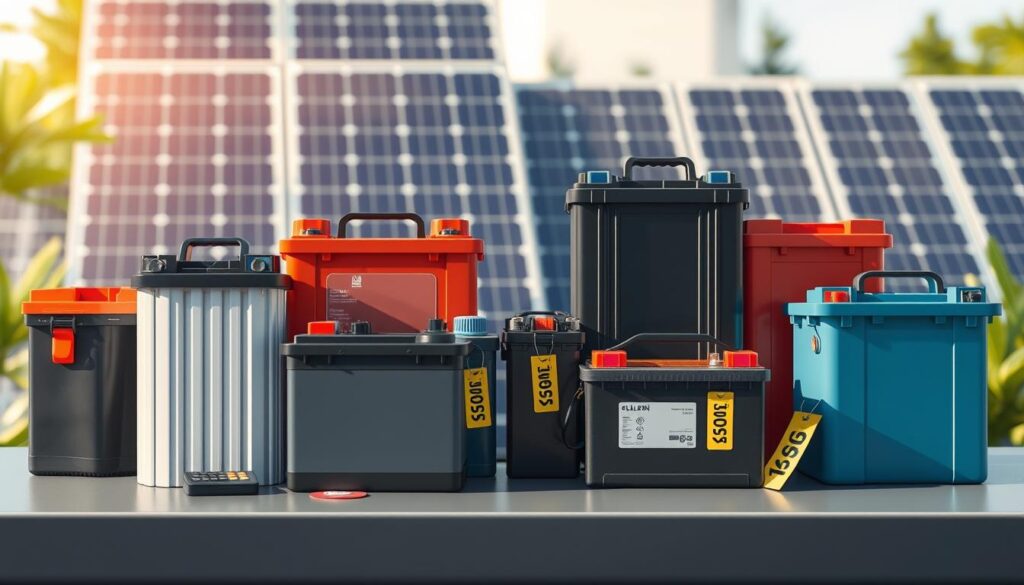
Compatibility with Your Solar System
Choosing the right battery for your solar system is key. You need to match the voltage, pick the correct charge controller, and check inverter compatibility. Integrating your battery well with your solar setup is vital for the best performance and energy use.
Matching Voltage Requirements
First, check if your battery’s voltage fits your solar panels’. This is important because wrong voltages can cause problems and damage. Most home solar panels are 12V, 24V, or 48V. Make sure your battery matches your panel setup.
Choosing the Right Charge Controller
The charge controller controls the electricity flow from panels to battery. Pick one that works with your panel and battery types. This ensures your battery lasts longer and works better.
Inverter Compatibility
The inverter turns your battery’s DC power into AC power for your home. It’s important to choose an inverter that fits your battery. Many systems use hybrid inverters for easy solar and battery use.
Thinking about these factors helps your solar battery work well with your system. This means better energy storage and use.
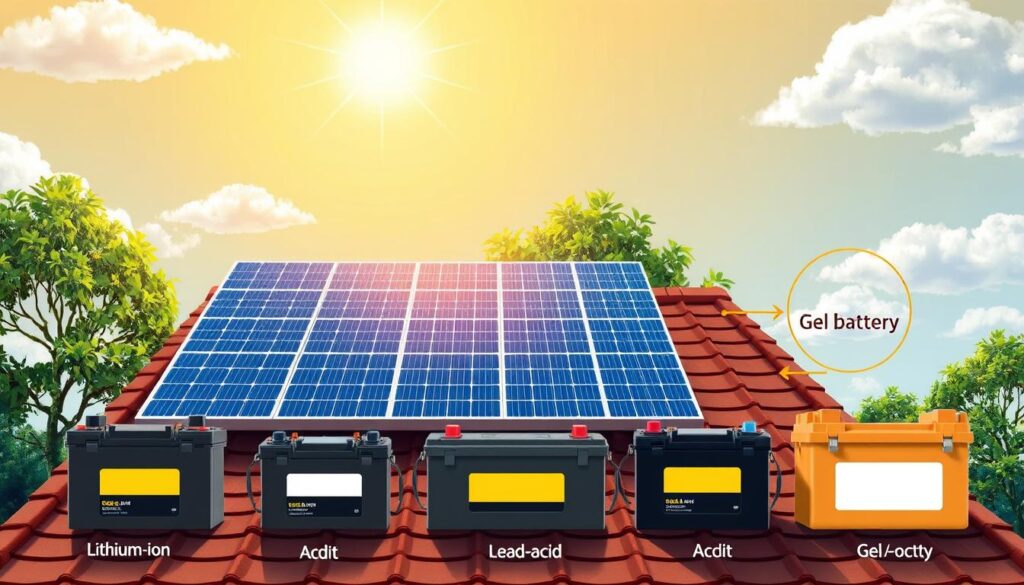
Assessing Your Energy Needs
Choosing the right battery for your solar panel system starts with understanding your energy use. Knowing how much energy you use daily, seasonally, and during peak times helps pick the best battery size and capacity for you.
Calculating Daily Energy Consumption
The average U.S. home uses about 30 kilowatt-hours (kWh) of energy each day. This number can change based on your home’s size, how many people live there, and your energy-saving habits. Look at your past utility bills to see how much energy you usually use.
Determining Peak Usage Times
Find out when your energy use is highest, like during meals, in the evening, or when big appliances are running. Knowing these times helps pick a battery that can handle these energy peaks and keep power steady all day.
Seasonal Variability in Energy Needs
- Look at how your energy needs change with the seasons. For example, using more energy for heating or cooling in extreme weather can really increase your use.
- Plan for extra backup power for a few days to cover times when the sun isn’t shining well, especially in winter or bad weather.
By carefully looking at your energy use and peak times, you can find a solar battery that makes your system work best. It will also make sure you have power when you need it.

Installation Requirements for Batteries
Setting up a solar panel system means installing batteries carefully. While DIY might save money, professional installation is safer and more efficient as it ensures your solar battery setup works well.
DIY vs. Professional Installation
Installing solar batteries yourself can be dangerous if you don’t know the safety rules and local codes. Experts can set up your system right, following all safety standards. They also help with permits and rules in your area.
Safety Protocols and Best Practices
Working with solar batteries needs to be safe. Following safety regulations is key to avoid risks like fires or electrical issues. Pros know how to handle these parts safely, using the right tools and precautions.
Space Considerations for Battery Placement
Where you put your solar battery installation matters a lot. Some batteries fit on walls, while others need floor space. Make sure there’s enough room for the batteries and easy access for upkeep and future upgrades.
Working with solar experts helps your system get installed right. This means it’s safe, efficient, and follows all rules. It also makes your renewable energy investment worth it, giving you reliable power at home or work.
Maintenance and Care for Solar Batteries
Keeping your solar batteries in good shape is key to their long life. Regular battery maintenance and checking how they perform can make your solar system work better and last longer.
Regular Inspections and Monitoring
Watch your battery’s performance with your solar system’s software. Look for signs like lower capacity or efficiency. Also, check the battery terminals for corrosion and clean them when needed.
Signs of Battery Wear and Tear
Older batteries might charge less, discharge faster, and work less efficiently. Spotting these signs means it’s time for some upkeep or a new battery.
Maintenance Tips for Longevity
- Keep batteries in the right temperature to avoid damage. Some, like Tesla’s, have special features to keep them cool or warm.
- Charge batteries fully every 3 weeks to stop corrosion and slow down aging.
- Don’t let batteries run out completely, as it can harm them and shorten their life.
- Always follow the maker’s advice on how to charge, discharge, and care for your batteries.
By keeping up with battery maintenance and monitoring their performance, your solar batteries will keep providing power for many years.
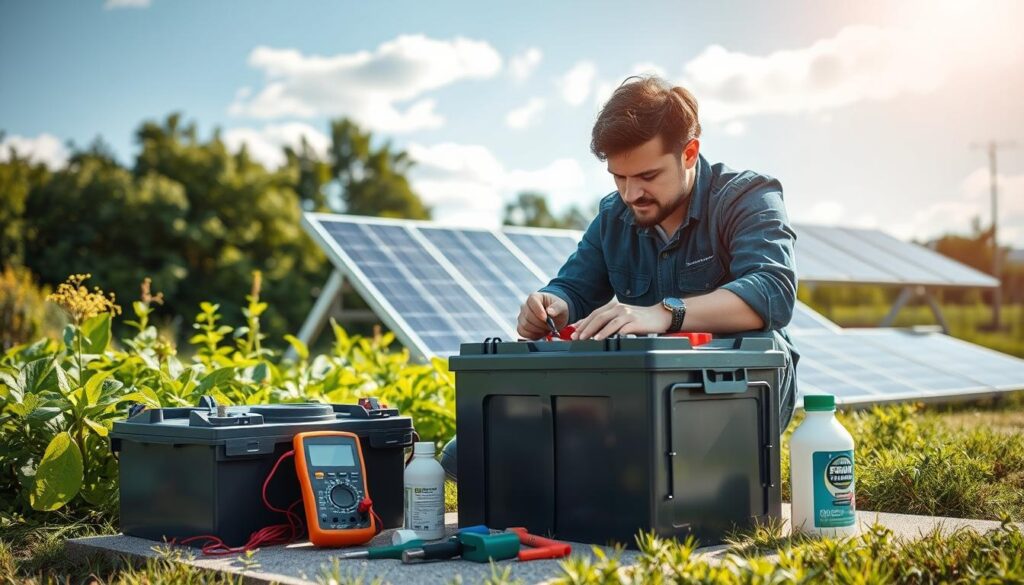
“Proper maintenance can significantly extend the useful life of your solar batteries, ensuring your energy system continues to operate at peak efficiency.”
The Future of Solar Battery Technology
The need for clean energy is growing fast. Battery tech is getting better, leading to a greener energy future. New designs and smart tech are changing how we store and use energy from the sun.
Innovations in Battery Design
Solid-state batteries are a big deal in battery tech. They pack more energy, are safer, and last longer than old lithium-ion batteries. These batteries use solid stuff instead of liquid, making them a game-changer for solar power.
The Impact of Smart Technology
Smart tech is making solar batteries smarter. AI and machine learning help manage energy better. This means better storage and more control over energy use for homes and businesses.
Trends in Renewable Energy Storage
Iron flow batteries are another exciting new thing. They store energy for a long time, which is better than old batteries. These batteries use liquid that can be recharged and stored for a long time, great for big solar projects.
The solar industry is always getting better. New battery tech, smart energy management, and better storage are key. These advancements will make solar power more reliable, efficient, and affordable for everyone.
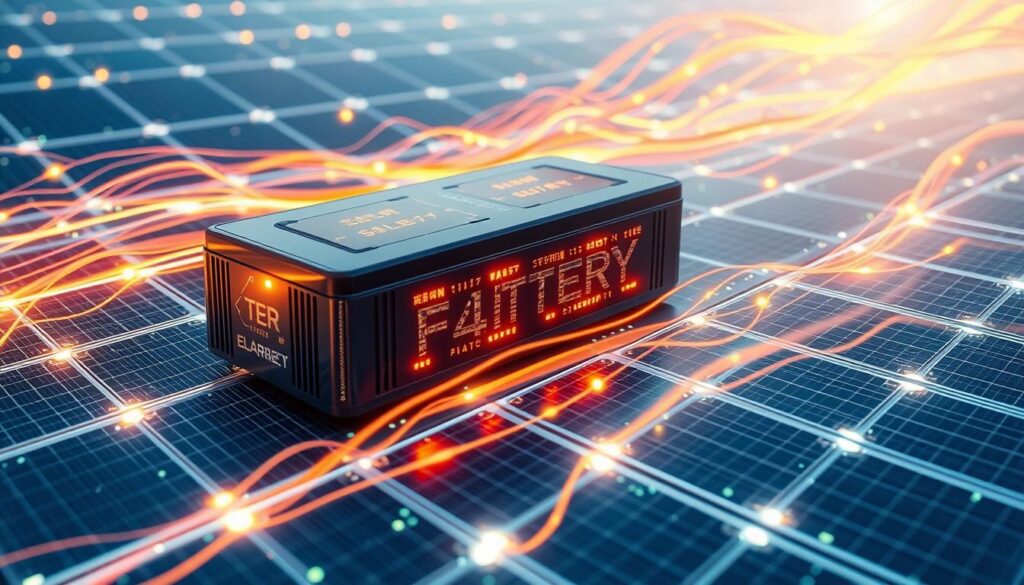
Environmental Impact of Your Battery Choice
Choosing the right battery for your solar panel system is key also because it affects how green your renewable energy setup is. We’ll look at recycling, eco-friendly options, and the greenness of various solar battery types below.
Recycling Options for Old Batteries
Lead-acid batteries are common but need special disposal to avoid harming the environment. Luckily, almost all of them are recycled, which helps a lot. Lithium-ion batteries are also getting recycled more, making them better for the planet.
Eco-Friendly Battery Alternatives
New battery techs like organic flow and solid-state lithium batteries are greener. They use safer materials and are easier to recycle. This aims to cut down on the carbon footprint of storing energy.
Sustainability in Solar Energy
The greenness of your solar+storage system depends on its whole life cycle. Lithium-ion batteries cost more upfront but last longer and need less upkeep. This means they save money and are better for the environment over time. As new battery techs get cheaper, they might be even greener for storing solar energy.
| Battery Type | Recyclability | Lifespan | Environmental Impact |
|---|---|---|---|
| Lead-Acid | Over 99% recycled | 5-15 years | Higher carbon footprint due to lead production |
| Lithium-Ion | Growing recycling infrastructure | Typically 10+ years | Lower environmental impact, more energy-dense |
| Organic Flow | Promising recyclability due to eco-friendly electrolytes | Emerging technology, potentially longer lifespan | Minimal environmental harm, sustainable materials |
Thinking about the environmental impact of your battery choice helps you pick a greener option. This supports sustainable energy storage and a cleaner future.
Conclusion: Making an Informed Decision
As mentioned before, choosing the right solar battery is key and it needs careful thought about many factors. These include capacity, efficiency, lifespan, and cost. Each one is important for a good solar energy storage solution.
Recap of Key Points
In this guide, we talked about why picking the right battery is important. We looked at the different types of batteries and what to consider. We also discussed how to check efficiency and performance, and how to stay within your budget.
Final Thoughts on Battery Selection
When choosing a solar battery, think about your energy use, budget, and green goals. Keep up with new tech and changes in incentives. Talking to solar experts can help you make the best choice for your needs. This way, you’ll get the most from your solar system and save money and the planet. Also look at the possibility of reconditioning your battery, depending on the type of battery that you have, so that you can save money.
FAQ
What are the different types of batteries used in solar panel systems?
Solar panel systems use several types of batteries. These include lead-acid, lithium-ion, saltwater, and AGM batteries. Each battery type has its own benefits and drawbacks, like cost, efficiency, and environmental impact.
What factors should I consider when choosing a solar battery?
When picking a solar battery, think about a few key things. Look at the battery’s capacity and power rating. Also, consider its depth of discharge, round-trip efficiency, warranty, and if it fits with your system.
How do I determine the right battery size for my solar system?
To find the right battery size, start by looking at your energy use. Consider your peak usage times and how it changes with the seasons. For off-grid systems, aim for enough power to last a few days without sunlight.
What are the benefits of using a solar battery?
Solar batteries have many advantages. They provide backup power, lower your energy bills, and cut down on carbon emissions. They store energy for when the sun isn’t out and keep your lights on during power cuts.
How do I maintain and care for my solar battery?
Keeping your solar battery in good shape is important. Check how it’s doing, watch for any signs of wear, and keep it at the right temperature. Clean the terminals and follow the maker’s advice on charging and using it. You can also read about how to recondition your batteries to bring old batteries back to life here.
What are the environmental considerations when choosing a solar battery?
The green impact of solar batteries depends on the type. Lead-acid batteries need special disposal, while saltwater batteries are easier to recycle. Lithium-ion batteries are getting more recycling options, and new tech like organic flow batteries might be even greener.
How do I ensure my solar battery is compatible with my solar panel system?
Make sure your battery’s voltage fits your system’s needs. Also, pick a charge controller and inverter that work well with your battery and panels.
What are the cost considerations for solar batteries?
Solar batteries usually cost a lot to install. But, they qualify for a 30% tax credit from the federal government (in the USA), while local utilities might offer extra incentives. Think about the long-term savings on your energy bills when looking at the cost.
What are some emerging technologies in the solar battery space?
New tech includes solid-state batteries for better energy and safety. Iron flow batteries offer longer, greener storage. Smart tech and AI are also being added to make batteries work better.
Source Links
- How to Choose the Best Battery for Your Solar System
- Navigating the Choices: How to Select the Right Solar Energy Battery Storage for Your Needs
- How to Choose the Proper Battery for Your Solar Application – ShopSolar.com
- Solar Battery Buying Guide: Here’s All You Need to Know Before Making Your Purchase
- How to Choose from 5 Types of Solar Batteries | WHC SOLAR
- How to Choose the Best Battery for Your Solar System
- What Are The Different Types Of Solar Batteries?
- Types of Solar Batteries in 2024: A Comprehensive Guide
- How to Choose the Best Battery for Your Solar System
- How to Choose the Best Battery for Your Solar System
- How to Choose the Best Solar Battery for your Home
- 6 Factors For Choosing The Best Solar Battery
- How to Choose the Best Battery for Your Solar System
- How to Select the Best Battery for Your Solar Energy System – Energy Serv
- How to Choose the Best Battery for Your Solar System
- How to Pick the Best Solar Battery – 2024 Buyer’s Guide
- How to Choose the Best Battery for Your Solar System
- Which Type of Battery Is Best for a Home Solar System?
- How do I know if my solar panels are compatible with battery storage? (2024) | 8MSolar
- How to choose the best solar battery for your needs
- How to choose the best battery for a solar energy system – Infinity Renewables
- How to Choose the Best Battery for Your Solar System
- How To Size Batteries for a Solar Panel Systems | Paradise Energy
- Solar Battery Maintenance Guide
- How to choose the best battery for a solar energy system
- Choosing the Best Battery For Your Solar Energy System
- Choosing the Right Solar Battery for Your Solar System
- How to Choose the Best Battery for Your Solar System
- Choosing the Right Solar Battery – New England Clean Energy
- 5 Things To Consider When Choosing Your Solar Battery
- How to Choose the Best Battery for Your Solar System
- 12 Steps To Pick The Right Solar Battery – Smartly Energy
